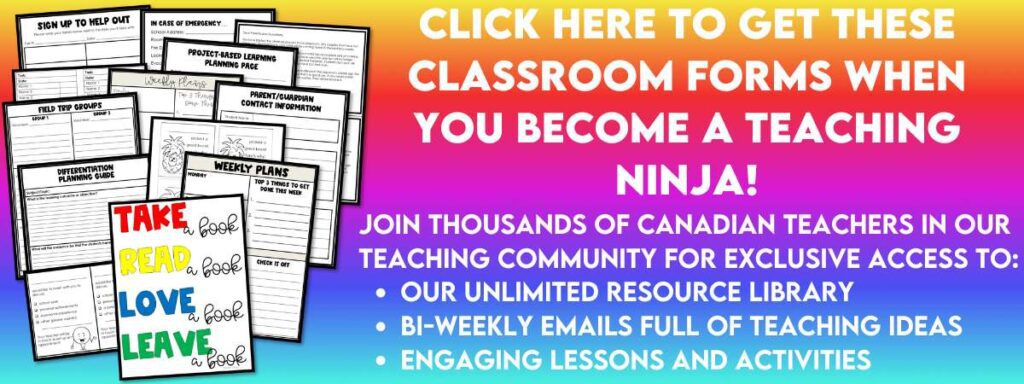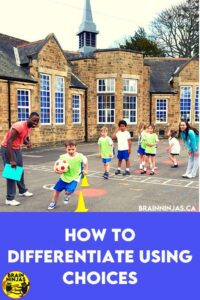
How would you feel if you knew you were a wonderful writer but the only way you could express yourself was through modern dance? What would you do if you had to recite your report card comments by memory to each and every parent? How would you feel if you were given the choice to write your report cards any way YOU want? (Ours would be invisible!)
Imagine how different your life would be if you were given the choice to do or say certain things.
Wouldn’t that be amazing? Wouldn’t that make you want to write the best report cards the world has ever seen? So why are we so determined as teachers that there’s only one way to assess our students? Why can’t they have choices too?
What if you allowed to students to pick the type of assessment they wanted to do as long as they still showed you how well they understood?
Providing Choices is One Way to Differentiate Your Instruction

The idea behind providing choice is not to give students all the choices all the time. In fact, we recommend limiting the number of choices (or you’ll have students that just cannot decide). We recommend creating two options for a task and letting students choose between just those two (or three once they are pretty good at making the right choice for them).
When you give students choices, it helps them learn to advocate for what they need or want. It’s similar to a toddler being given two options (and maybe neither is very appealing) but because they chose, they feel empowered.
Let’s Break It Down
We admit this philosophy won’t work for everything because there are certain things we have to assess. If you are checking to see if students can write a paragraph, they’ll have to write a paragraph, but there are still several choices that they could be making:
- What is the paragraph about?
- Will they write on paper or use a digital device?
- Will they have to type or can they use a speech-to-text program?
- If they’re writing on paper, what type of lines? Double spaced?
- Can they write with a pencil or pen?
- Where will they sit when they work?
- How long will they have?
So, we’re not saying to give students every choice every time, but giving students a few choices puts them in control-which is sometimes the carrot needed to get the work done well.
Here is what we’ve learned happens to engagement when students choose…they’re engaged! POOF! And it didn’t require costumes or props! Your students will be engaged because they have choices.
If you are just starting to figure out differentiation in your classroom, you might be interested in reading Debunking Five Differentiation Myths. We also have a differentiation planning checklist to help you get started. It can be found in our Resource Library, along with many other general classroom forms to help you organize your classroom.
We can send you a copy of the differentiation planning pages when you sign up for our email list.

What are some ready-made assignments students can do?
We’ve developed several activities that provide students with choices. We’re not saying you need to buy any of them, but these are examples where students can have choices and the quality of work we receive is exceptional!
If project-based learning is new to you, start with this post: The Reasons for Project-Based Learning.
Design a Fur Trading Post
This is a project-based learning task that allows students to research the Canadian fur trade and then present their learning in a variety of ways. Students are hired by archeologists to scout out the location of a fictional fort from the past in this project-based learning activity. The choices are how they will represent their fur trading post: a drawing, a sculpture, out of Lego, using Minecraft or anything else they can think of. As a teacher, you have the choice of how many options your students have to choose from.
Find Design a Fur Trading Post in our TpT Store ($USD) or BN Shop ($CAN).
Design a Carnival Attraction
This project uses what students have learned about simple machines to design a carnival attraction such as a Ferris wheel or roller coaster. The choice provided in this project is which ride or attraction they’ll create. This is a favourite for students and teachers because it’s so much fun and students have to learn so much to get their rides to work properly. A teacher can choose to have unlimited choices or limit them to a few.
Find Design a Carnival Attraction in our TpT Store ($USD) or BN Shop ($CAN).
Design a Weather Instrument
This project has students take what they have learned about how weather is measured to build a device that measures a few types of weather such as rainfall or temperature. The choices provided in this project are the types of devices or the materials that are used. There is also another option for the teacher to provide: how the project will be presented. We’ve had students do oral presentations, demonstrations and slide shows that showed the steps to build the weather device.
Find Design a Weather Instrument in our TpT Store ($USD) or BN Shop ($CAN).
Electricity STEM Challenges
These mini-projects work backwards. Students are given the result and they can choose how they get their device or creation to provide the result. The engagement of students with these challenges is usually through the roof. They make a big mess, but the learning is huge too! Teachers can choose which materials are available and students choose how they use them (within reason of course because safety matters).
Find Electricity STEM Challenges in our TpT Store ($USD) or BN Shop ($CAN).
Wetlands Physical and Behavioral Adaptations
This project is a classroom favourite and we have students ask about it each year. Students take what they have learned about how plants and animals survive in wetland ecosystems and design a brand new plant or animal. The student’s choice is the actual creature or plant while the teacher can choose how many requirements will be included and what materials students will use to create their creatures or plants (it can be a drawing, painting or some other wonderful and interesting choice).
Find Wetlands Physical and Behavioural Adaptations in our TpT Store ($USD) or BN Shop ($CAN).
Structures and Building STEM Challenges

This set of challenges has students learn about building different items for strength, durability and lots of other goals. It works similarly to the electrical devices challenges mentioned above, in that students are given a goal and then make choices about how they try to reach the goal. A teacher can decide which challenges the class can complete and which materials they will have available to use. They can also decide how long students will have to meet each challenge.
Find Structures and Building STEM Challenges in our TpT Store ($USD).
And yes, most science activities lend themselves well to choices, but remember you can keep it simple with simple choices-seating, tools, lights on or dimmed, music on/not on, colour of paper, when it’s due, working independently or in a group. The choices you can provide are endless.

Is there such a thing as too many choices?
Yes. Simply put too many choices lead to confusion and indecisiveness. We recommend having one or two choices per activity when it is appropriate.
You do not need a choice for every single thing. Sometimes the teacher can make a choice and that’s just the way it is.
Sheena Iyangar did a Ted Talk a few years ago that talks about how too many choices actually limit our productivity. We recommend taking a moment to watch it if you have about fifteen minutes: How to Make Choosing Easier.
Where can I provide choices?
Keep in mind we do not provide all of these choices at the same time, but here is a list of possible choices you can provide in your classroom.
Providing choices is one of the easiest ways to differentiate for your students. Read more: Differentiate in Less Time and How to Differentiate Your Instruction.
Physical Space:
- where can students sit?
- what types of chairs/benches/cushions/specialty seating options are available to students?
- who can they sit with?
Writing Tools:
- are students using pen, pencil, markers, digital devices?
- can students use digital tools such as speech-to-text, voice recorders, video recordings?
- can students use photographs to document their work?
- will students print/handwrite/type?
- will students hand in a physical copy or email/digital document?
Topics/Subjects
- what format will the assignment be: letter, paragraph, play, script, poem, essay, video, photograph, modern dance, oral presentation, slide show or any other format you can imagine?
- which topic will students be learning about/researching/presenting/writing?
Instruction
- how will your students learn the information: reading, listening, watching videos, hands-on?
- are you mixing up the types of assignments your students are offered? Can they choose between answering questions or writing a report?
- Try giving them a worksheet of 25 questions. Ask them to complete 12. They are still doing the work, but there’s not need to do all 25 (especially if they’re all correct) and then they feel like they get to choose the ones they can do successfully.
- do your students have a choice of what they can read? This might not work for every reading lesson, but can you ask something as simple as nonfiction or fiction to start and then do the other book next time?
Making It Easier
When you are giving your students choices, we found it best to have a list prepared if students are going to get to choose a topic. Students just pick from the list. We always leave an option for students to come talk to us if they’ve thought of something that is missing from the list.
Collect the Tools

Collect the tools on a list that you let your students use. As your school year builds your students will choose the ones they prefer and can do the most successfully. Don’t worry if they all pick the “fun” options at first. The novelty wears off and students start to pick the ones that best suit them and their learning preferences.
Teach your students that not every tool is right for every job. It doesn’t make sense to create a video if the assignment is to write a great sentence that using quotation marks. Letting students choose will help them learn how to make the right choices at the right time.
Set the Expectations
Be sure to give your students clear expectations regardless of the choice they might make. It is necessary to explain that regardless of where or what they are doing, the work will need to be completed or the teacher will get to make some of the choices (which the student may not enjoy as much).
When There Are No Choices Available
When a choice isn’t an option (like district testing or a field trip) explain to students that even though choices are great, there are times in life when choices aren’t possible. It’s important to model and explain that when a student doesn’t get to choose, they just have to do their best and let it go.
Never letting your students make any choices will result in frustrated students who will look much less engaged and may even act out. Boost the engagement in your classroom by making students feel like they are in control (even when they aren’t).
Sometimes the simplest little things can make a huge difference. One of the strangest choices was whether to work with the lights on or off. We turned the lights on one side and the other off and students got to choose which side of the room they worked on. They loved it-that was such a weirdo class. 🙂
Give it a try! We’ll let you make your own choice about where you’re going to start. Let us know what you tried in the comments below.






